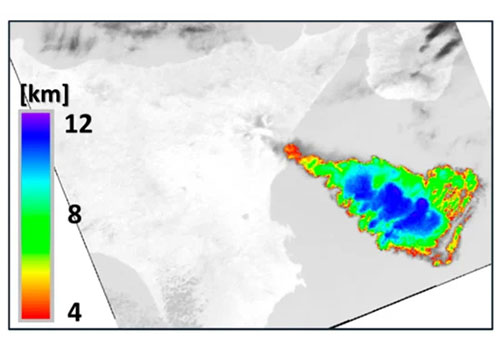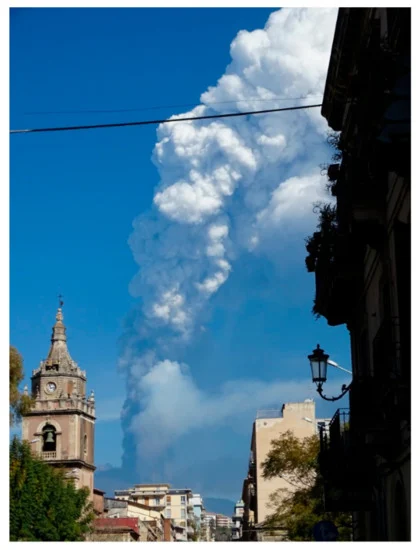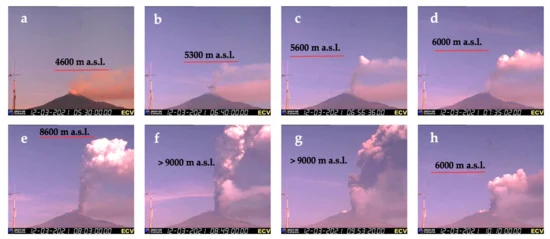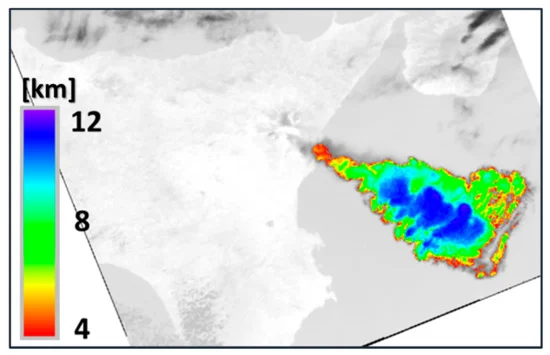Analizzato, attraverso tecniche multidisciplinari, l’evento di fontana di lava che ha interessato l’Etna il 12 marzo 2021. Lo studio, condotto da un team dell’Osservatorio Etneo dell’INGV, ha permesso di definire in quanto tempo una fontana di lava forma una colonna eruttiva e per quanto tempo quest’ultima si disperde nell’atmosfera.
Tra i vari episodi di fontane di lava che hanno interessato l’Etna nella prima metà del 2021, quello del 12 marzo si è potuto studiare in dettaglio grazie alle eccezionali condizioni meteorologiche che hanno consentito una visibilità ottimale del fenomeno.
La ricerca ha evidenziato come il pennacchio di cenere si sia formato entro mezz’ora dall’inizio dell’evento, abbia raggiunto i 12,6 km di quota e sia rimasto in atmosfera per circa due ore dopo la cessazione delle fontane. Questi alcuni dei risultati dello studio “Anatomy of a Paroxysmal Lava Fountain at Etna Volcano: The Case of the 12 March 2021, Episode” condotto dai ricercatori dell’Istituto Nazionale di Geofisica e Vulcanologia e recentemente pubblicato sulla rivista ‘Remote Sensing’.
“Durante quest'anno”, spiega la ricercatrice Sonia Calvari, primo autore dello studio, “l’Etna ha avuto diversi episodi di fontane di lava. Abbiamo voluto analizzare con metodi multiparametrici quello che ci è sembrato il più intenso e che, tra l’altro, è avvenuto di giorno e con condizioni meteorologiche favorevoli.
In dettaglio, abbiamo utilizzato tre metodiche diverse di cui ognuno degli autori della ricerca è specialista. Io ho analizzato le immagini delle telecamere di monitoraggio gestite dall’Osservatorio Etneo dell’INGV, Gaetana Ganci ha utilizzato le tecniche satellitari e delle routine automatiche da lei appositamente sviluppate per l’analisi di immagini termiche ottenute da telecamere fisse, e Alessandro Bonaccorso ha utilizzato l’analisi delle deformazioni rilevate con una stazione dilatometrica, ovvero un sensore installato in un pozzo profondo circa 150 metri, situato a circa 10 km dalla zona sommitale dell’Etna, che registra così un segnale scevro da qualsiasi influenza superficiale di natura antropica o meteorologica”.
“Attraverso il confronto dei dati raccolti abbiamo potuto ottenere il volume totale eruttato. Inoltre abbiamo potuto rilevare, per la prima volta, come il volume totale del materiale eruttato durante questa fontana di lava sia stato inferiore alla somma delle colate laviche e della parte piroclastica: c’è infatti una parte del materiale prodotto dalle fontane che rifluisce lungo il pendio del vulcano e va ad alimentare le colate laviche”.
“Infatti”, prosegue la ricercatrice “abbiamo calcolato che durante questo evento eruttivo è stato emesso un volume totale di 3 milioni di metri cubi di materiale, valore ottenuto dal dilatometro. Dai dati satellitari abbiamo ottenuto la quantità di lava eruttata, pari a 2,4 milioni di metri cubi, mentre dall’analisi delle immagini delle telecamere abbiamo ottenuto 1,6 milioni eruttati sotto forma di materiale piroclastico. La differenza tra il valore totale ottenuto dal dilatometro e la somma dei due parziali ottenuti dall’analisi delle telecamere e dai dati satellitari, che corrisponde al 30% del materiale piroclastico, è dovuto al fatto che quest’ultimo è rifluito lungo il pendio per gravità ed è andato ad alimentare le colate laviche”.
“La ricerca”, conclude Sonia, Calvari “proseguirà con l’analisi di tutti gli eventi di fontane di lava che si sono verificati dal dicembre dello scorso anno e che tuttora si verificano, al fine di cogliere delle variazioni nel tempo che possano far capire la possibile evoluzione del fenomeno e i processi che avvengono nel sistema di alimentazione del vulcano”.
#ingv #etna #sicilia #eruzione #vulcano #ricerca #geoscienze #remotesensing
Etna. Analyzed the 12 March 2021 lava fountain and the formation of the eruptive column
Analyzed, through multidisciplinary techniques, the lava fountain event that occurred at Etna on 12 March 2021. The study, carried out by a team of the INGV Osservatorio Etneo, allowed us to define how much time a lava fountain would take to form an eruptive column and for how long the latter will expand into the atmosphere.
Among the various episodes of lava fountains that occurred at Etna in the first half of 2021, that of 12 March was studied in detail thanks to the exceptional weather conditions that allowed for optimal visibility of the phenomenon.
The research has shown that the ash plume was formed within 30 minutes from the start of the event, reached 12.6 km of elevation, and remained in the atmosphere for about two hours after the cessation of the fountains. These are some of the results of the study "Anatomy of a Paroxysmal Lava Fountain at Etna Volcano: The Case of the 12 March 2021, Episode" carried out by researchers from the Istituto Nazionale di Geofisica e Vulcanologia and recently published in the journal 'Remote Sensing'.
"During this year", explains the researcher Sonia Calvari, first author of the study, "Etna had several episodes of lava fountains. We wanted to analyze with multiparametric methods what seemed to us the most intense and which, among other things, occurred during the day and with favorable weather conditions.
In detail, we used three different methods of which each of the authors of the research is a specialist. I analyzed the images of the monitoring cameras managed by the INGV Osservatorio Etneo, Gaetana Ganci used satellite techniques and automatic routines that she developed specifically for the analysis of thermal images obtained from fixed cameras, and Alessandro Bonaccorso used the analysis of the deformations detected with a dilatometric station, i.e. a sensor installed in a well about 150 meters deep, located about 10 km from the summit area of Etna, which records a signal free from any surface influence of anthropic or meteorological nature".
“By using the dilatometer data we were able to obtain the total erupted volume. Furthermore, we were able to detect, for the first time, how the total volume of the material erupted during this lava fountain was less than the sum of the lava flows and the pyroclastic part: there is in fact a part of the material produced by the fountains that flows along the slope of the volcano and feeds the lava flows".
“In fact”, continues the researcher, “we calculated that during this eruptive event a total volume of 3 million cubic meters of material was emitted, a value obtained from the dilatometer. From satellite data we obtained the amount of lava erupted, equal to 2.4 million cubic meters, while from the analysis of the camera images we obtained 1.6 million cubic meters erupted in the form of pyroclastic material. The difference between the total value obtained from the dilatometer and the sum of the two partials obtained from the analysis of the cameras and satellite data, which corresponds to 30% of the pyroclastic material, is due to the fact that the latter flowed along the slope by gravity and went to feed the lava flows ".
"The research" concludes Sonia Calvari "will continue with the analysis of all the events of lava fountains that have occurred since December last year and that still occur, in order to capture variations over time that can make us understand the possible evolution of the phenomenon and the processes that take place in the volcano's feeding system".
#ingv ##ingv #etna #sicily #eruption #volcano #research #geoscience #remotesensing









